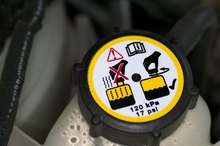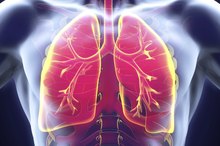What Does Carbon Do for Human Bodies?
The element carbon is not found in a pure form in the human body, but rather in compounds within the body. Carbon constitutes roughly 18 percent of body mass, and millions of carbon atoms form the thousands of molecules in virtually every cell. Carbon is the basic building block required to form proteins, carbohydrates and fats, and it plays a crucial role in regulating the physiology of the body. Gaseous and liquid compounds that contain carbon also can affect the body.
Cellular Respiration
Cellular respiration is a process through which the body releases energy stored in glucose, which is a compound composed of carbon, hydrogen and oxygen. That energy is used to produce adenosine triphosphate, or ADP, which scientists call the "energy currency" of the cell. During respiration, the body oxidizes glucose and energy is released. The oxygen in the compound is reduced to water, while the carbon atoms in the glucose are released as carbon dioxide.
The Respiratory System
Toxic Vapors Emitted From New Tires
Learn More
Scientists estimate that a human being breathes about 20,000 times a day, thanks to the components of the respiratory system -- the nose, throat, windpipe, voice box and lungs. The air that people breathe consists of several gases, with oxygen most important for cell growth and energy. Carbon dioxide, a waste gas, is produced when carbon is mixed with oxygen during cellular metabolism. It is possible, though, to have too much or too little carbon dioxide in the blood. Too much carbon dioxide can be associated with such conditions as Cushing's syndrome, Conn's syndrome, severe vomiting, restriction of blood flow and lung ailments. Too little carbon dioxide, often caused by hyperventilation, can make muscles tense and cause people to become tense, anxious, stressed and even aggressive.
Carbon in Activated Charcoal
A carbon-based substance, activated charcoal -- very fine particles -- can be a life-saver. It is a highly porous substance, able to bind many harmful substances, and often is used in hospital emergency rooms to treat drug overdoses and chemical poisonings. It is given by mouth to conscious patients, and through a tracheal tube in unconscious patients. The drug or chemical attaches to the surface of the charcoal. Because charcoal is not "digested," it stays inside the gastrointestinal tract and eliminates the toxin through bowel movements. Activated charcoal also is used to reduce intestinal gas and treat bile flow problems during pregnancy.
Danger of Carbon Monoxide
Glycerine Vs. Glycol
Learn More
Carbon monoxide can kill. The gas forms when there is not enough oxygen to produce carbon dioxide -- essentially when the carbon in fuel is not burned completely. Carbon monoxide prevents oxygen in the blood from being carried throughout the body, causing asphyxiation. Exposure to carbon monoxide can severely affect the elderly and people with cardiovascular or lung disease. Low concentrations can cause headache, loss of alertness, nausea, fatigue, hyperventilation, confusion and disorientation. High concentrations can result in a coma or death.
Related Articles
References
- State University of New York: Clinton Community College: Cellular Respiration
- Mineral Information Institute: The Role of Elements in Life Processes
- Agency for Toxic Substances & Disease Registry: Toxic Substances Portal: Carbon Monoxide
- Live Science: The Chemistry of Life: The Human Body
- National Endocrine and Metabolic Diseases Information Service: Cushing's Syndrome
- Medline Plus: Respiratory Acidosis
- Lab Tests Online: Bicarbonate
- Lab Tests Online: Conn's Syndrome
Writer Bio
Glenn Singer is a longtime professional journalist in South Florida who has specialized in medical, business, aviation and consumer reporting. He has worked extensively as a supervisory editor and copy editor and he also teaches journalism at the university level.









